Getting Back to the Basics with Legendary Off-Roader
Ford Motor Company is calling 2004 "The Year of the Car" as it tries to resuscitate its ailing car sales, but then at the
2004 North American International Auto Show it had to slip in a concept SUV that just sent my spine tingling with excitement.
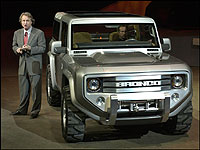 |
| Ford Motor Company VP of Design J Mays introduces the Ford Bronco Concept Sunday January 4, 2004 at the North American International Auto Show in Detroit, Michigan. (Photo: Ford Motor Company) |
The silver color two-door Ford Bronco that rolled out Jan. 4 to the front of the stage that Ford had set up in Cobo Arena, was a surprise, since I was expecting the press conference to focus on future new car products, like the Five Hundred, the Mustang, the Focus, and the Freestyle crossover. The blocky vehicle before me was something sculpted and reminiscent of the black Bronco that my late uncle "Chick" had owned when he was a lieutenant in the Allen Park (Mich.) Fire Department.
And, unlike most Ford brand vehicles that have the blue oval plastered on the front and back, the name "Bronco" was stamped on the front grille, and "Ford" was stamped in big block letters on the tailgate, reminiscent of Ford trucks of old.
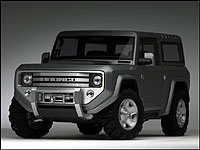 |
| The Bronco concept borrows the iconic design cues of the original, from its upright profile to short wheelbase, and the round headlamps. (Photo: Ford Motor Company) |
J Mays, Ford's Vice President of Design, the man who designed Volkswagen's New Beetle when he worked at the German automaker, stepped out of the Bronco concept like a proud father to introduce it.
"This tough little 'ute' draws on the spirit of the original Bronco, from an era of authentic, honest SUVs," Mays said. "This vehicle is meant to be tough, it's meant to be raw, it's rugged. It really is as if we had started with a solid chunk of iron and chiseled out just enough room for people, a spare tire, and very little else. The Bronco is meant to function more as a piece of equipment than a status symbol."
Harkening Back to the Original
The original two-door Bronco rolled off of Ford's assembly lines in time for sale in August 1965 as an answer to Kaiser Jeep's CJ and Wagoneer, the latter of which only sold a few thousand a year, Toyota's rugged Land Cruiser FJ and the International Harvester Scout. The appeal of these early SUVs was for outdoorsmen who needed four-wheel drive for hunting and fishing excursions into the countryside and many of these early vehicles, despite their barebones styling, were bought by fairly well to do families.
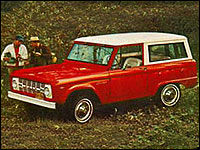 |
| The original two-door Bronco rolled off of Ford's assembly lines in time for sale in August 1965 as an answer to Kaiser Jeep's CJ, Toyota's rugged Land Cruiser FJ and the International Harvester Scout. (Photo: Ford Motor Company)
|
The Bronco came with a 92-inch wheelbase in three body styles:
- A four-passenger wagon with removable full-length roof;
- A pickup with a half roof and open rear;
- And, a two-door roadster with a choice of two- or four-passenger seating that proved to be unpopular and was discontinued after 1968.
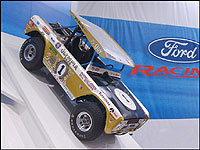 |
| The 1970 Big Oly Ford Bronco driven by Parnelli Jones that won the Baja 1000 race in 1971 and 1972 on display at SEMA 2002. (Photo: Ford Motor Company)
|
The original vehicle was built from 1965-1977 before it was replaced with the full-size F-series pickup based Bronco in 1978, which only lasted two years in its first draft but actually ran right up until 1996 receiving styling updates to match F-series mods over the years. Model year 1980 saw the much smaller Bronco II come to market, which in turn lasted until 1990 when it was more or less replaced with the larger Explorer.
But getting back to the original, it was a rugged no-thrills vehicle that could be equipped with winches, snowplow blades, tow hooks, an optional 11.5 gallon auxiliary gas tank, and more.
The first Bronco had the Falcon's 105 horsepower, inline six-cylinder engine and a three-speed manual transmission with a tall column-mounted shifter--with a shift pattern like that of a T-handle, but with a J-handle ball mounted on top--that enthusiasts called "three on the tree." And it had drum brakes, said to be more suitable for serious off-roading. Production for the 1966 model year was about 18,200 units.
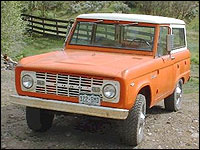 |
| More than 230,000 Ford Broncos were made between 1966 and 1977. (Photo: Ford Motor Company)
|
Ford also offered its small-block 289 cubic inch V8 as an option in 1966 and then its 302 c.i. V8 in 1969. The four-wheel drive vehicle was set up for maximum ground clearance, with its solid front axle again optimal for 4x4 adventures.
More than 230,000 Broncos were made between 1966 and 1977. A record 30,700 Broncos came off the assembly line for the 1977 model year, more than twice the number produced in 1976, and nearly 4,000 more than its second best year in 1973.
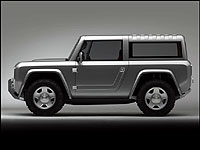 |
| Ford's Bronco concept vehicle is meant to look tough, as if the designers started with solid chunk of iron and chiseled out just enough room for people, a spare tire, and very little else. (Photo: Ford Motor Company)
|
Both the Bronco and the Bronco II had rollover issues--if the vehicle "tripped" when traveling at high speed or if you drove it carelessly while off-roading, a problem my uncle had warned me about his early Bronco that he still drove for many years.
Concept Makes a Statement
The Bronco concept borrows the iconic design cues of the original, from its upright profile to short wheelbase, and the round headlamps, Mays said. Modern elements include the three bar grille, where the word "Bronco" is milled and the word "Ford" gets a similar treatment on the tailgate.
"Plus the Ford Bronco has numerous details like exposed door hinges and U-shaped door handles," he said. "If we brought it into production, this two door Bronco would fit in just under Escape both in terms of both size and price. It is ideal for work or play; or for just plain making a statement."
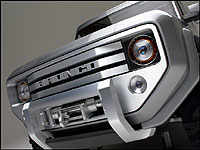 |
| The Concept is powered by a 2.0-liter, 16-valve, common-rail Duratorq diesel mated to Ford's new six-speed "PowerShift" transmission. (Photo: Ford Motor Company)
|
The concept sport-ute also has a few surprises. First it is powered by a 2.0-liter, 16-valve, common-rail Duratorq diesel along with Ford's new six-speed "PowerShift" transmission and "Intelligent" four-wheel drive system, that is designed to offer far better traction and vehicle stability than the original Bronco while providing better fuel economy (12 percent over four-speed transmissions) and smoother operation. The intercooled turbodiesel engine originates from Ford's European vehicles and delivers 128 hp (130 PS) and delivers peak torque at 244 lb-ft (330 Nm) at only 1,800 rpm. Imagine that kind of power for towing and off-roading.
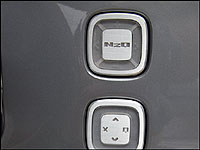 |
| By pressing the top button marked NO2 on the dashboard, the driver of the Bronco concept will give the engine a nitrous oxide kick, delivering a temporary boost of 50 hp and increasing top speed 16 to 24 km/h (10-15 mph). (Photo: Ford Motor Company)
|
Plus, the engine was designed to provide an overboost, an extra surge of power, for climbing hills with 258 lb-ft (350 Nm) of torque for limited amounts of time under full throttle.
Bronco Gets Nitrous "Kick"
There are more surprises for this concept, such as the use of nitrous oxide (N2O) to give the Bronco even more of a "kick" of power.
For moviegoers who saw "The Fast and the Furious" in 2001 and the sequel last year, you get the idea that N2O gives vehicles a performance boost. It was actually first applied in World War II when Allied aircraft used it for emergency bursts of airspeed and altitude climbing ability, and it grew into the hotrodding community by the 1970s.
Basically, nitrous injection works because each N2O molecule has two parts of nitrogen and one part of oxygen. During the engine's compression cycle, N2O breaks down, releasing its oxygen atoms that, in turn, allow more fuel to be burned. The nitrogen atoms keep the cylinder pressures from getting out of hand.
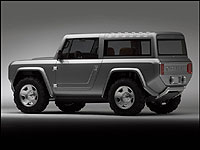 |
| The 4WD system on the concept is the same that is going to be introduced on the 2005 Escape. (Photo: Ford Motor Company)
|
The driver of the Bronco concept can inject nitrous oxide into the engine cylinders as long as the N2O button on the dash is held down, giving it a 50 hp jump. This kick allows the Bronco to trim its quarter-mile (0.4 km) times by three seconds while increasing top speed by 16 to 24 km/h (10-15 mph).
The 4WD system on the concept is the same that is going to be introduced on the 2005 Escape.
Expresses Minimalism Inside and Out
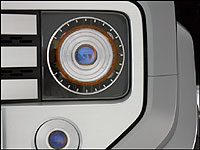 |
| While the round headlamps of the Bronco concept may look reminiscent of the original's shape, this vehicle incorporates modern LED and halogen lamp technology that can wider beams than incandescent lights for better vision at night in off-road situations. (Photo: Ford Motor Company)
|
About three years ago, during an interview with J Mays, he told me he was working on various "minimalist" designs. Well, the Bronco design must have been influenced by this line of thought.
The interior and exterior of the Bronco are stark. On the outside, the Bronco does use some updated technology, such as round LED and halogen headlamps that cast wider beams than incandescent lights for better vision at night in off-road situations. The rectangular taillamps are rectangular, much like the original, but are LED lights in a cascaded array.
And, the "ute" has Goodyear's LT 265/70R18 all-terrain tires mounted on 18-inch, six-spoke aluminum wheels.
There are only two seats inside, with a material that resembles leather work gloves, while a full-size tire is mounted in the rear cargo area--the place where my uncle probably put his deer carcasses in his Bronco after hunting up in northern Michigan.
The instrument panel is really barebones, just an analog speedometer and an odometer/compass. There are silver finish and brushed aluminum accents outside and inside the concept, including the steering wheel where the Ford oval finally appears, stamped in the center.
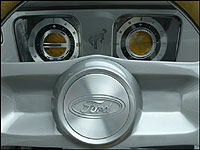 |
| The instrument panel is really barebones, just an analog speedometer and an odometer/compass. There are silver finish and brushed aluminum accents outside and inside the Bronco. (Photo: Ford Motor Company)
|
The glove box has an integrated grab handle to aid the passenger in getting in, while the corrugated interior floor panels give it that industrial, rugged look.
Placed Under Wraps
Once Mays was done introducing the Bronco, the SUV disappeared from the arena and did not return, even after the rest of Ford's new vehicles, such as the Five Hundred sedan and Freestyle crossover wagon, were introduced. It was as though Ford wanted to keep it under wraps and not spoil its "Year of the Car" theme.
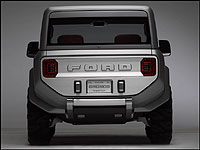 |
| Instead of the familiar blue oval, the Ford name is milled into the tailgate, reminiscent of Ford's trucks of old. (Photo: Ford Motor Company)
|
The Bronco did reappear in Ford's display on the main floor of the Cobo Convention Center, but not until the next day on a turntable that was behind a glass wall. And, with all of the carmaker press conferences that were stacked on top of one another, I didn't get another chance to take a close look at it.
But, the next best thing was talking to one of the designers that worked on it, Joe Baker, and I had to ask him, why bring back the Bronco? After all, the Explorer that initially replaced it has been a runaway success ever since and the more recent Escape shows up around every street corner.
"Because it is a living legend. Like Mustang and Thunderbird, it's one of those names that everyone knows and everyone knows what it stands for," Baker said. "We are testing the waters to see if it is the right thing to do."
Is There a Market?
Sport utility vehicles have been getting quite large, even the former compact ones such as the Toyota RAV4 and Honda CR-V are gaining in size, but Ford thinks there is room to slip in a small, two-door Bronco just below the Escape, Baker said.
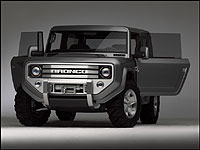 |
| Ford thinks there is room to slip in a small, two-door Bronco just below the Escape. (Photo: Ford Motor Company)
|
Two door SUVs, though, seem to be going out of style. Ford had eliminated the two-door Explorer Sport from its lineup, after all. But, Bronco seems to be a special case.
"Everyone knows what a Bronco looks like and everyone knows that the original 1965 Bronco was a two door," Baker said. "People have very fond memories of that car. It is completely appropriate for this car to have two doors and, on a car this size, you don't need four doors."
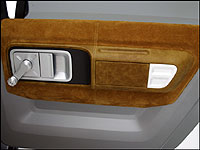 |
| "It is completely appropriate for this car to have two doors and, on a car this size, you don't need four doors." (Photo: Ford Motor Company)
|
Production variants, though, could include a small suicide or quarter door on back for those buyers who insist on added convenience.
No Prior Experience with Bronco
Baker grew up in England and had no previous experience with the original Bronco, full-size replacement or the Bronco II when he was assigned to work on the concept vehicle around March of last year. Of course, he didn't know about the Ford Galaxie 427 when he was assigned to do the 427 concept vehicle (a similar design to the future production 2006 Futura) in 2002.
But, he grew up in the land of the Land Rover Defender, and knew about the desires of that market, he said.
"What we were trying to do with the Bronco was to cut away the excessive luxury and the sophistication of current SUVs and get back to something that was far more raw and unique," he said. "The original Bronco had just a strong following with enthusiast clubs and rock crawling clubs that we felt that they were owed something and that we could do a new Bronco and do the original one justice with this car."
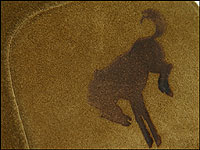 |
| Ford wanted to cut away the excessive luxury and the sophistication of current SUVs, and go back to raw basics. (Photo: Ford Motor Company)
|
While the concept is just a two seater, a production car could have a removable secondary row seat or four permanent seats. For the show car, the designers wanted the spare tire in the back to give the vehicle a feeling of added rigidity and toughness.
Keeping it Authentic
Key to the Bronco design is that it is a very upright, straightforward, clean surface vehicle.
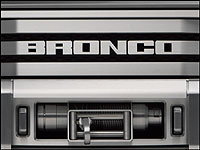 |
| The Bronco is a living legend for Ford, with a name strong enough to stand on its own. (Photo: Ford Motor Company)
|
"To do anything with a faster windscreen (windshield) or a slimmer roofline wouldn't have come across as authentic as the original," Baker said. "The Bronco has an upright front, upright glass, with a box on the back. That's probably the key thing to get back to its authenticity."
Another part of its authentic heritage is having the words "Ford" and "Bronco" stamped on the outside.
"We think the Ford brand is strong enough to just be written out," he said. "Ford has such a strong enough name, why not just spell it out? The same with the bronco name in the front, because the Bronco is a living legend, you don't have to use the Ford oval. Everyone knows it's a Ford. It couldn't be from any other company."
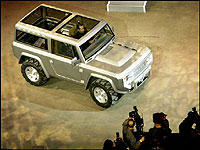 |
| Should the Bronco go into production, it could be built on a traditional, truck-like, body-on-frame chassis or it could go on a unitized body. (Photo: Ford Motor Company)
|
For the purposes of building the concept car, the Bronco was placed on a modified Escape platform. Should it go into production, it could be built on a traditional, truck-like, body-on-frame chassis or it could go on a unitized body, like modern cars and crossover SUVs such as the Escape. It all depends on customer demand, Baker noted.
For me, I think I'd like one in black.
Specifications:
- Body Type: 2-door SUV, unibody
- Layout: front engine, 4WD
- Engine: 128 hp (178 hp if NO2 button engaged), 244 lb-ft of torque (258 under full throttle), 2.0-L, turbodiesel I-4
- Transmission: 6-spd manual
- Seating Capacity: 2
- Website: www.ford.ca
Check the photo album for additional, larger photos.

















